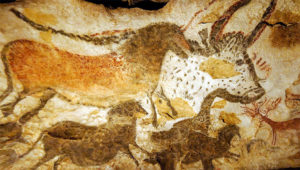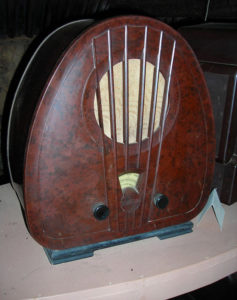Home » Beginnings…
Beginnings...
Early interest in decoration and use of colour
The geometric scratches on this clam shell from Java may not seem like an impressive piece of artwork, but they were done roughly 500,000 years ago! Anatomically modern humans did not reach that area for at least another 400,000 years. It appears that the urge to decorate our bodies and surroundings predates even the evolution of modern man.
The ‘Venus of Tan-Tan’found in Morocco, is between 200,000 and 500,000 years old. There are minute traces of iron oxide red on its surface, so it may have originally been coloured with red ochre. The oldest rock carvings found so far are at least 290,000 years old.
It appears that the use of pigments predates the amazing prehistoric cave art, done with charcoal and various naturally occurring chalks some 25,000 to 40,000 years ago.
People probably used naturally occurring colours to decorate their bodies, belongings and surroundings since the dawn of mankind.
Inorganic pigments containing Iron and Manganese oxides can last almost indefinitely if protected from light and weather. Organic colouring materials (pigments and dyes) extracted from plants and animals were probably also known by our early ancestors. Evidence of their use is much harder to find because they decompose and disappear with time.
This 6,200 year old cotton cloth from Peru is the earliest known textile decorated with indigo dye from the indigo plant. Dyeing with indigo was a biochemically complex process. Synthetic indigo is still a very important dye today. It is the dye that colours our blue jeans.
The leather in this 4,000 year old Egyptian archer’s quiver was dyed with alizarin red extracted from the madder root. This method of colouring leather was very complex and time consuming. It involved Soda Ash and Aluminium. It could take up to 2 years to produce a vibrant red piece of leather.
Both the blue cotton and the red leather quiver are sophisticated items that would not look out of place in a modern craft market. The technology behind them must have been developed by trial and error over hundreds, if not thousands of years.
Although relatively recent, the Maya Blue colour in this mural deserves a mention. It was made by heating a mix of plant-sourced indigo and palygorskite clay at 150°C – 200°C. The resulting turquoise blue pigment was remarkably stable – able to survive over 1,000 years in a subtropical climate. Current interest and research into this type of organic-inorganic nano composite could result in a new class of plastic colourants becoming available.
Dawn of the Age of Plastics
In the Victorian era the game of billiards became very popular. The best billiard balls were made from elephant ivory and manufacturers were keen to find an alternative.
In 1869 John Wesley Hyatt created celluloid from nitrocellulose, alcohol and camphor. Celluloid used to make synthetic billiard balls saved a lot of elephants. The first flexible photographic film was also made from celluloid. Movie film became a huge market for celluloid from around 1900.
In 1907, phenolic – a phenol-formaldehyde resin, became commercially available under the trade name ‘Bakelite’. Marketed as ‘The Material of a Thousand Uses’, Bakelite was used to manufacture everything from telephone handsets and costume jewellery to light bulb sockets to automobile engine parts and washing machine components.
Together, celluloid and phenolic, the first mass-marketed synthetic plastics, launched the ‘Age of Plastics’.
Many of the plastics in use today were either discovered or made practical following World War I. These included PVC, PVDC, LDPE, Acrylic, Polyurethane, Polystyrene, PTFE, Nylon, Neoprene and Polyester; with HDPE and polypropylene, following shortly after World War II.
By the time plastics became widely available after World War II, the rather limited range of naturally occurring colorants, was largely replaced for industrial applications (including plastics) with a wide range of synthetically produced pigments and dyes. Naturally occurring colourants contain impurities, are weaker in tint strength and more variable in shade than their synthetic counterparts.
Most of the inorganic colorants we use today were synthesized in the 18th and 19th centuries. The notable exception is Titanium Dioxide white, which only became widely available after World War I. Organic pigments suitable for plastics continued to be developed during the 20th century. The very important phthalocyanine blues and greens became available in the 1930s. Thus the plastics colourist had a large palette of synthetic inorganic and organic pigments at their disposal.
© Vibron 2018







